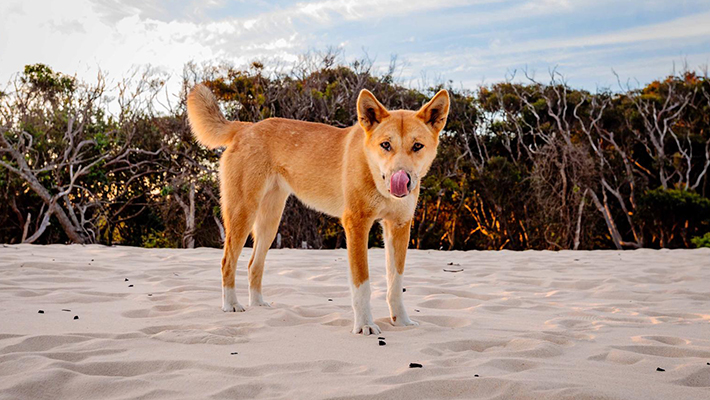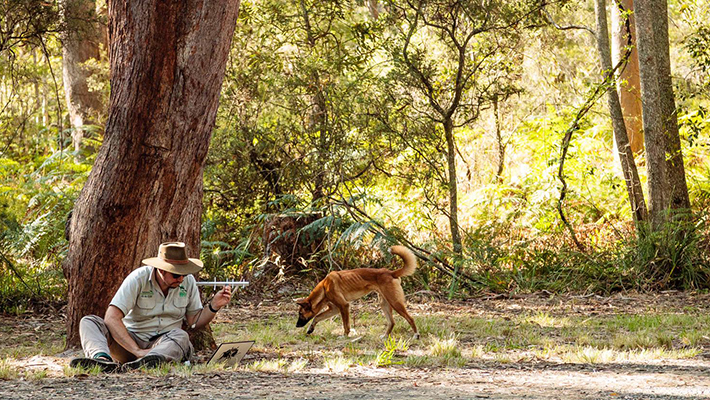Developing a scent-based management tool for Dingoes and other Wild Dogs in Australia
Dingoes are estimated to have arrived in Australia around 4000 years ago and as an apex species, have helped to shape and regulate ecosystems over this time. Management of dingoes in Australia is primarily driven by the interests of the livestock industry and is typified by the use of physical barriers and lethal control. At the same time there is also an increasing understanding that dingoes have cascading benefits on ecosystems, including suppressing invasive species. A more nuanced approach to dingo management, with the aim of protecting livestock while retaining the ecosystem benefits of dingoes, is therefore much needed.
This project aims to develop biologically relevant predator management tools based on the dingo's natural communication system. As in many carnivores, dingoes communicate territorial ownership using scent-marks and vocalizations. These signals may also affect the space-use of subordinate predators including invasive predators, and therefore potentially lead to improved conservation of threatened and non-threatened native species. Understanding how long particular critical signals persist in dingo scent marks under natural conditions is critical to applying these territorial signals to manage the movements of dingoes in key areas including around reintroduction sites and livestock areas.
UNSW Honours student, Ben Walker, supervised by Dr Neil Jordan, has undertaken scent collection work at the Dingo Discovery Centre, north of Melbourne to determine and quantify changes in the chemical composition of dingo urine.
Studies are being conducted using Gas-Chromatography Mass-Spectrometry (GCMS) analysis of urine to determine the information content of dingo signals.
Scent exposure trials have been conducted at Taronga Western Plains Zoo, with individual scents split and these sub-samples exposed to the elements for different lengths of time. GCMS analysis on these samples will reveal how long the key messages persist, which is ultimately essential in devising a schedule for deploying scents as part of a conservation management tool.
Scent presentation experiments have been conducted in the Strezlecki desert. Preliminary assessments suggest that repeat visits to dingo scents were much reduced compared to control sites. Comprehensive analysis needs to occur, but this is an exciting indication that dingo scent may have a repellent effect on other dingoes and highlights its potential use as a non-lethal management tool.


The Myall Lakes Dingo/Dapin Project
As Australia’s apex terrestrial predator, dingoes are culturally and ecologically important, but they can also impact human safety, livestock, and in some circumstances, they may also be identified among threats to endangered native species.
The Myall Lakes Dingo/Dapin Project is a collaboration between Taronga and the University of NSW, working closely with NSW National Parks and Wildlife Service and the Mid Coast Council to balance the impacts of dingoes, and implement evidence-based conservation management. The project also works with local Traditional Owners to gain insights into the dingoes and their importance and represent First Nations views and knowledge in research and management.
We’re seeking to improve our understanding of dingo behaviour for management, develop and test non-lethal dingo management tools, and develop a framework for coexistence with dingoes. The Myall Lakes Dingo/Dapin project uses an evidence-based approach to manage human-dingo interactions in NSW’s Myall Lakes region. Taronga is working with partners UNSW, NPWS, the Mid Coast Council, Local Land Services and the TIDE (Taree Indigenous Development and Employment) Rangers on this project.
Our scientists are undertaking in-depth studies of the ecology and social interactions of dingoes, their interactions with the human environment and their role as an apex predator in the ecosystem. This includes annual dingo population surveys and assessing public perceptions towards dingoes. Community outreach forms a major component of this project, and educational resources such as posters, leaflets, guidebooks and websites are being developed through this project to educate the Myall Lakes community about dingo-safe behaviours.
This year, the team has continued to monitor several dingo packs using tracking collars and camera traps across urban and natural landscapes. Results from three consecutive annual population surveys have shown the dingo population to be stable, with higher densities of dingoes found closer to urban areas. Frequent consultation with managers and other stakeholders, and formal integration of research knowledge into the Mid Coast Council’s formal dingo management procedure, have collectively resulted in reductions in human-dingo conflict reports and a reduced use of lethal control. Further research outputs have highlighted the roles of dingoes in suppressing invasive foxes. The project currently supports four PhD and two Honours students, all focused on dingo ecology underpinning conservation management.
This project aims to develop and test non-lethal tools for dingo management, and to further our understanding and appreciation of this iconic Australian carnivore. Find out more